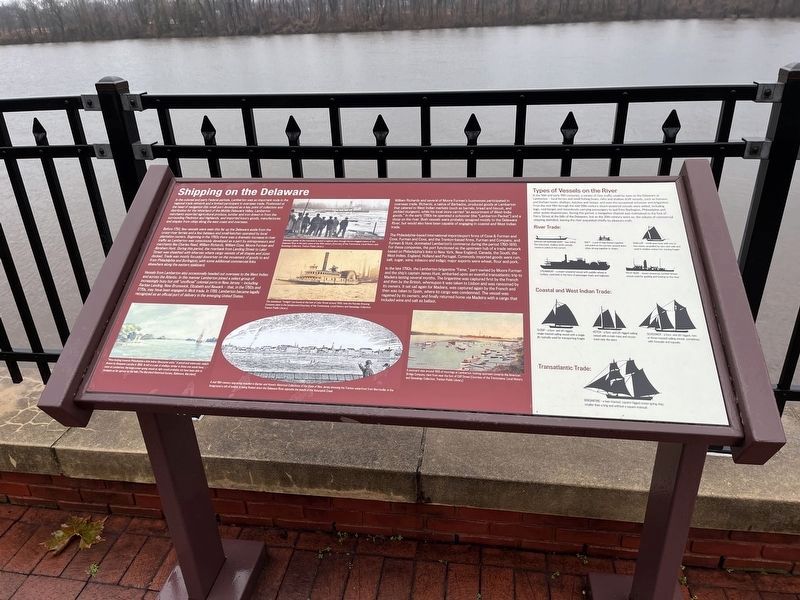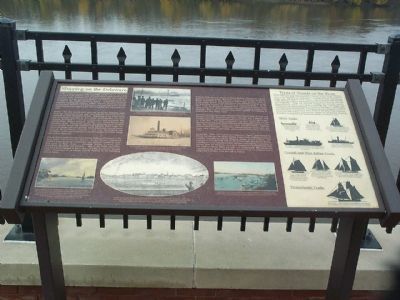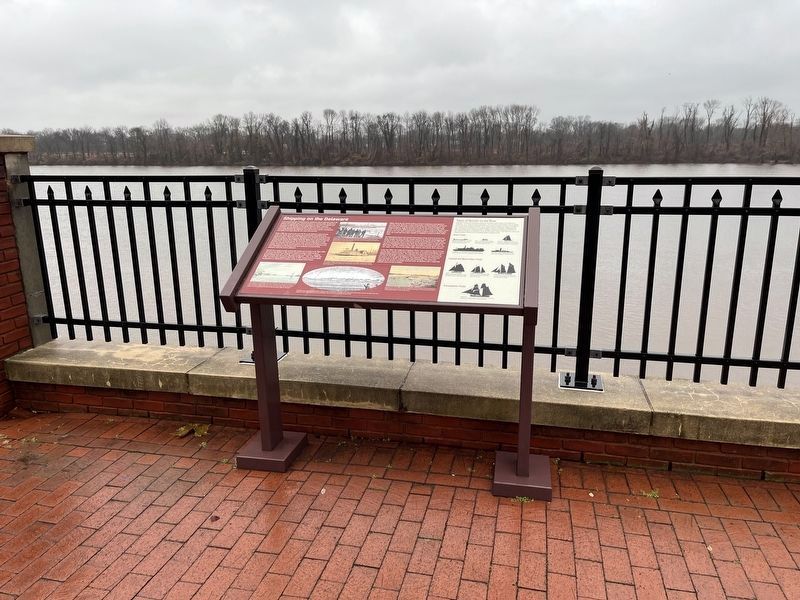South Trenton in Mercer County, New Jersey — The American Northeast (Mid-Atlantic)
Shipping on the Delaware
In the colonial and early Federal periods, Lamberton was an important node in the regional trade network and a limited participant in overseas trade. Positioned at the head of navigation this small port developed as a key point of collection and distribution for the hinterland of the Middle Delaware Valley. Lamberton merchants exported agricultural produce, lumber and iron drawn in from the surrounding Piedmont and Highlands, and imported luxury goods, manufactures and staples from cities along the east coast and overseas.
Before 1750, few vessels were seen this far up the Delaware aside from the cross-river ferries and a few bateaus and small ketches operated by local plantation owners. Beginning in the 1760s there was a dramatic increase in river traffic as Lamberton was consciously developed as a port by entrepreneurs and merchants like Charles Read, William Richards, William Coxe, Moore Furman and Abraham Hunt. During this period, the riverbank from Landing Street to Lalor Street was sheathed with wharves where cargo vessels of all shapes and sizes docked. Trade was mostly focused downriver on the movement of goods to and from Philadelphia and Burlington, with some additional commercial links elsewhere along the eastern seaboard.
Vessels from Lamberton also occasionally headed out overseas to the West Indies and across the Atlantic. In this manner Lamberton joined a select group of increasingly busy but still “unofficial” colonial ports in New Jersey – including Raritan Landing, New Brunswick, Elizabeth and Newark – that, in the 1760s and 1770s, may have been engaged in illicit trade. In 1789, Lamberton became legally recognized as an official port of delivery in the emerging United States.
William Richards and several of Moore Furman’s businesses participated in overseas trade. Richards, a native of Barbados, produced goods at Lamberton that catered to West Indian markets (such as sugar molds, barrels, bread and biscuit, and pickled sturgeon), while his local store carried “an assortment of West-India goods.” In the early 1780s he operated a schooner (the “Lamberton Packet”) and a sloop on the river. Both vessels were probably assigned mostly to the Delaware River, but would also have been capable of engaging in coastal and West Indian trade.
The Philadelphia-based international import/export firm, of Coxe and Furman, and the Trenton-based firms, Furman and Company, and Furman and Hunt, dominated Lamberton’s commerce during the period 1760-1810. For these companies, the port functioned as the upstream hub of a trade network based on Philadelphia’s link to New York, New England, Canada, the South, the West Indies, England, Holland and Portugal. Commonly imported
goods were rum, salt, sugar, wine, tobacco and indigo; major exports were wheat, flour and pork.
In the late 1790s, the Lamberton brigantine “Fame,” part-owned by Moore Furman and the ship’s captain James Hunt, embarked upon an eventful transatlantic trip to Madeira lasting several months. The brigantine was captured first by the French and then by the British, whereupon it was taken to Lisbon and was ransomed by its owners. It set sail again for Madeira, was captured again by the French and then was taken to Spain, wher its cargo was condemned. The vessel was regained by its owners, and finally returned home via Madeira with a cargo that included wine and salt as ballast.
Types of Vessels on the River
In the 18th and early 19th centuries, a variety of river traffic could be seen on the Delaware at Lamberton—local ferries and small fishing boats; rafts and shallow draft vessels, such as bateaus and Durham boats; shallops, ketches and sloops; and even the occasional schooner and brigantine. From the mid-19th through the mid-20th century steam-powered vessels were added, including tugs, coal barges and steamboats carrying passengers to and from Burlington, Philadelphia and other points downstream. During this period, a navigation channel was maintained to the foot of Ferry Street at the falls of the Delaware, but as the 20th century wore on, the
Erected 2004 by New Jersey Department of Transportation.
Topics. This historical marker is listed in this topic list: Waterways & Vessels. A significant historical year for this entry is 1750.
Location. 40° 11.785′ N, 74° 45.468′ W. Marker is in Trenton, New Jersey, in Mercer County. It is in South Trenton. Marker can be reached from New Jersey Route 29. This marker is in South River Walk park which is built over top of Route 29. Touch for map. Marker is in this post office area: Trenton NJ 08611, United States of America. Touch for directions.
Other nearby markers. At least 8 other markers are within walking distance of this marker. Ferries across the Delaware (within shouting distance of this marker); A Natural Magnet for Native Americans (within shouting distance of this marker); Riverview Cemetery (about 400 feet away, measured in a direct line); South Riverwalk Park (about 500 feet away); Ice, Brewing and Bottles (about 600 feet away); c. 10,000 – 12,000 Years Ago (about 600 feet away); Paleo-Indians (about 600 feet away); a different marker also named Paleo-Indians (about 600 feet away). Touch for a list and map of all markers in Trenton.
More about this marker. The marker is in the southern half of the park overlooking the Delaware River.
Credits. This page was last revised on February 16, 2023. It was originally submitted on December 26, 2007, by Gary Nigh of Trenton, New Jersey. This page has been viewed 1,132 times since then and 11 times this year. Last updated on February 2, 2021, by Carl Gordon Moore Jr. of North East, Maryland. Photos: 1. submitted on December 18, 2022, by Devry Becker Jones of Washington, District of Columbia. 2. submitted on December 26, 2007, by Gary Nigh of Trenton, New Jersey. 3. submitted on December 18, 2022, by Devry Becker Jones of Washington, District of Columbia. • Bill Pfingsten was the editor who published this page.


